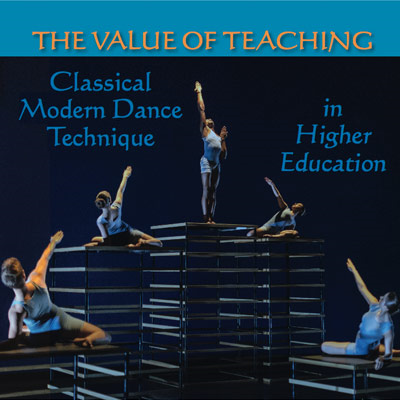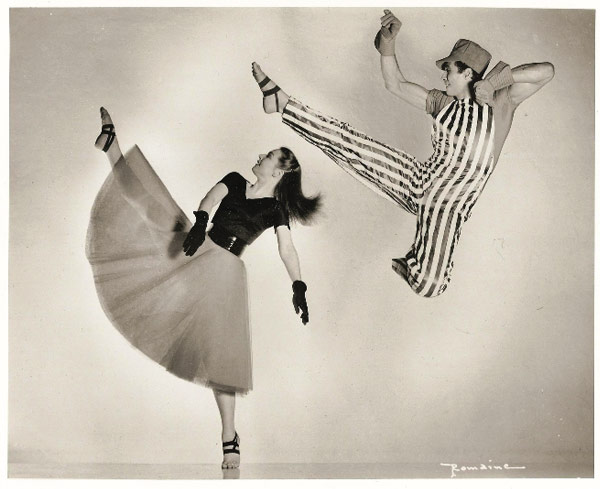The Value of Teaching Classical Modern Dance Technique in Higher Education
By Nancy LushingtonPublished online: 21 Feb 2017.
There has been much discussion in recent years on the efficacy of teaching classical modern dance forms in a college pre-professional dance program. Some argue that most of the dancers graduating from these institutions will not be dancing for the few modern companies that perform works based on these techniques, and that much of the contemporary work currently being performed relies on improvisation and contemporary styles. Jennifer Roche (2015) observed, “In recent years, the practice of contemporary dancers has altered significantly in the transition from canonical choreographic vocabularies to a proliferation of choreographic signatures within mainstream and independent dance” (Chapter 1, Introduction: Dancing Multiplicities). However, I have found that there is much to be gained from teaching young dancers the classical modern dance techniques as a foundation for all contemporary dance forms. Roche supported this in saying, “The immersion in a specific training approach can cultivate in-depth skills that give dancers the opportunity to differentiate between different choreographic languages” (Chapter 1, Introduction: Dancing Multiplicities). Several of the classical modern dance companies in New York have taken to performing a variety of repertory. The Martha Graham Dance Company invites contemporary choreographers to create work, as does Paul Taylor’s American Modern Dance, in addition to performing “Masterpieces of the 20th Century.” Training dancers in a variety of classical dance idioms gives them a broad movement vocabulary from which to draw. It encourages them to be organized within their bodies and to be versatile, ready to perform the diverse repertory that might be required through their professional careers.
 Montclair State University dancers performing May O’Donnell’s Powers of Ten (1984), as staged by Nancy Lushington in 2013. Photographer: Robert Cooper.
Montclair State University dancers performing May O’Donnell’s Powers of Ten (1984), as staged by Nancy Lushington in 2013. Photographer: Robert Cooper.
Much of today’s contemporary choreography is based on the principles of technique explored in the Graham, Horton, Humphrey-Weidman, Limón, O’Donnell, Dunham, Cunningham, and Nikolais techniques. These early choreographers and teachers grounded their techniques on the principles they were exploring within their choreography, but those movement ideas continue to be sound and relevant, and they are employed by many choreographers working today. Studio owner Aggie Kimple (2015) reiterated this idea, saying, “The best contemporary dancers have a strong base in the traditional style with polished technique. They combine their experience and skills to create ‘contemporary’ pieces that are new and exciting. The foundation in the traditional dance makes this possible” (Modern vs. Contemporary Dance).
In addition there is great value in the performance of classical modern dance repertory, for many of the same reasons. There is a strong argument for the reinforcement of the movement ideas and principles through the understanding of how it is applied in actual dances. Having learned and performed Humphrey’s Passacaglia and Fugue in C Minor (1938) and The Shakers (1930) as an undergraduate, I gained a kinesthetic understanding and appreciation that became physical knowledge, as well as an appreciation of the choreography that informed my own work in later years.
THE MAY O’DONNELL TECHNIQUE
I am fortunate to have worked with May O’Donnell as a dancer and a teacher in her school. I learned to teach the technique from O’Donnell and Gertrude Shurr (co-author with Rachael D. Yocum of Modern Dance: Techniques and Teaching). O’Donnell was a soloist with the Martha Graham Dance Company, creating her own roles (as she described) in such works as Appalachian Spring and Hérodiade. In addition, O’Donnell and José Limón choreographed and performed together for three years in California. Her technique is Graham-based in its use of contraction and release, but one can readily see the influence of Limón with his background with the Humphrey-Weidman technique and development of his own. The O’Donnell technique combines the power and force of Graham with the lyrical ebb and flow of Limón.
 May O’Donnell and Jose Limon in Three Inventories of Casey Jones (1941). Photographer: Romaine.
May O’Donnell and Jose Limon in Three Inventories of Casey Jones (1941). Photographer: Romaine.
Teaching O’Donnell technique provides teachers with a strong pedagogical foundation comprising a well-developed series of exercises and phrases, each with specific goals and objectives. O’Donnell technique begins with a floor warm-up, although I hesitate to use the word warm-up because there are so many specific technique ideas and principles that are introduced in the floor work. O’Donnell technique is based on contraction and release, not merely as a vehicle for expression, but as a catalyst for movement. O’Donnell said:
My class would start as a warm-up on the floor in what I called key positions. I had a sequence that developed neuromuscular awareness. Along with warming up the body, stretching and strengthening exercises were included. I liked to do these warm-up exercises, the essential vocabulary and positions in a sequence, not only to strengthen the back and entire body but also to stretch the skeleton. (Horosko 2005, 92)
O’Donnell constructed her technique, like most choreographers of her day, to serve her choreography; however, what developed was a fully structured syllabus for training dancers.
O’Donnell’s floor work enables dancers of various levels and abilities to begin to challenge their neuromuscular strength without having to be concerned with balance. The evolution of the floor work in class mirrors the evolution of the floor work in her dances. As the complexity of her experiments with the body moving in and out of the floor developed, so did the exercises that she devised to teach these ideas. In the center and across the floor, O’Donnell’s work stresses shift of weight. She explained, “I developed a sequence of movement patterns … in a standing position to develop their awareness of the shifting of weight from one position to another with the greatest ease, efficiency and safety” (Horosko 2005, 93). There is much attention paid to developing strength and articulation in the feet, as jumping, prancing, galloping, leaping, and as O’Donnell would often say “covering space” were key in her work. The footwork patterns start with simple articulation and escalate to include arms, legs, spinal articulation, and coordination. Inherent in the way that my colleagues and I approach teaching the work is to encourage critical thinking, to train dancers to be responsible for how they use their bodies, to insist that they have a deep understanding of the genesis of any given movement, and finally, to have them actively explore multiple options for the impetus of a movement.
Dance vocabulary is fundamentally a series of steps; in dance as an art form, those steps are transformed into a powerful language that can convey images and emotions, tell stories, and transport the audience. The deliberate development of the exercises is key in the education of well-trained dancers with instruments that will allow them to excel in the broad variety of contemporary work that is available to them in the dance world today. Understanding and addressing their own needs, and finding the motivation and initiation for movement ideas beyond the steps are also very important parts of their training. O’Donnell stated, “Positions and movements indicate emotional states, such as the singing and jaunty movements of happiness or the heaviness of sadness. Dancers must become aware of those emotional states. … Emotions are stirred through the movement. It’s the artist that has to do that for an audience” (Horosko 2005, 93).
The students who I teach at the college level are hungry for this kind of work and they are eager to learn, to understand, and to rise to the challenges. I ask my freshmen modern students to write about what they learn in the study of the technique. Dani Cole wrote:
With regards to connections and lasting energy, Ms. O’Donnell was particularly passionate about finding reasons for movement and articulating meaning through the manipulation of space and the body … The understanding of the body in space and its intentions supports this idea. Senses in O’Donnell class and performance are heightened and the body is not merely a moving object. The body becomes an active agent serving as a vehicle for semantic movement. (personal communication 2015)
Melanie Kimmel, a former student and now a contemporary dancer with Rioult Dance, said:
My exposure to the O’Donnell technique as a new freshman at Marymount Manhattan College provided me with the vital foundation for my future career as a student and now a professional dancer. The technique begins with what appears to be simplistic movement ideas but that are
ultimately what differentiate a deeply conscious and controlled dancer from one who can only access movements from the surface. O’Donnell teaches a dancer to reach deeper, becoming acutely aware of how to isolate the muscles and how this can both help or hinder movement. As a dancer in a company that fuses both O’Donnell and Graham techniques, my initial O’Donnell training helped to build a strong and limitless base as a dancer. (personal communication 2016)
Students’ responses to the work and their understanding of their bodies as moving artists are invaluable. Their ability to articulate and self-assess the work they are doing is crucial to their development as dancers, and learning the structured techniques of modern dance encourages this.
 Marymount Manhattan College Dancers in O’Donnell Technique Class
Marymount Manhattan College Dancers in O’Donnell Technique Class
FINAL THOUGHTS
May O’Donnell once said:
I saw Doris Humphrey’s work and liked it very much. It was real dance and had a lot of movement … I think Doris would have been an easier person for me to work with, more in tune with my natural self. But Martha forced me to think and move in a way that sometimes was not too natural for me. But it became part of my own movement experience, and I used it in my own way. (Horosko 2005, 91)Working with Graham forced her to move beyond what felt comfortable and natural. This is a prime example that having exposure to multiple and contrasting technical styles moves dancers into new spaces in their kinesthetic knowledge and capabilities. Dancers must develop a vocabulary, a body of physical data that they can call on to define, compare, and contrast with future movement experiences.Many colleges and universities offer courses that include traditional modern techniques from Graham and Limón to Horton and Nikolais. Their students are receiving a dance education that not only prepares them for a broad variety of dance styles, by systematic training in body movement principles, but also provides them with embodied knowledge and a deep understanding of modern dance history and the forms that have influenced generations of choreographers and performers. Many schools include required ballet courses in their curriculum because of ballet’s structure and its well-documented ability to develop the body into a facile instrument for choreography. I believe that this study of multifaceted codified techniques is incredibly valuable to inform dancers in movement principles and to develop personal identity that goes well beyond the specific technique and “style.”
REFERENCESHorosko, M. 2005. May O’Donnell: Modern dance pioneer. Gainesville: University Press of Florida.Kimple, A. 2015. Recent posts. Dance Design School Blog. http://www.dancedesignschool.com/blog/?p=98 (accessed November 2016).Roche, J. 2015. Multiplicity, embodiment and the contemporary dancer: Moving identities. London: Palgrave Macmillan.Shurr, G., and R. D. Yocum. 1949. Modern dance: Techniques and teaching. New York: A. S. Barnes.Address correspondence to Nancy Lushington, Dance Department, Marymount Manhattan College, 221 East 71st Street, New York, NY 10021. E-mail: nlushington@mmm.edu
This Article appeared in Dance Education in PracticeISSN: 2373-4833 (Print) 2373-4841 (Online) Journal homepage:
http://www.tandfonline.com/loi/udep20To link to this article:
http://dx.doi.org/10.1080/23734833.2017.1272289